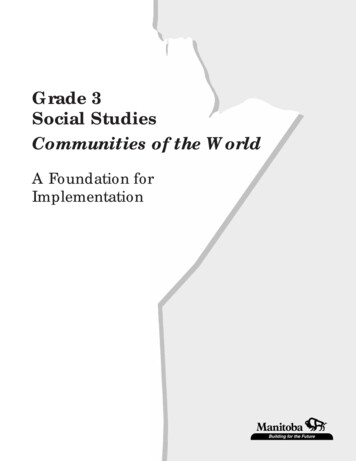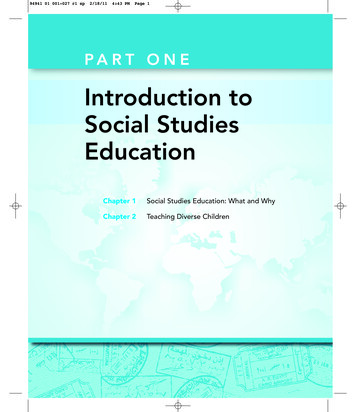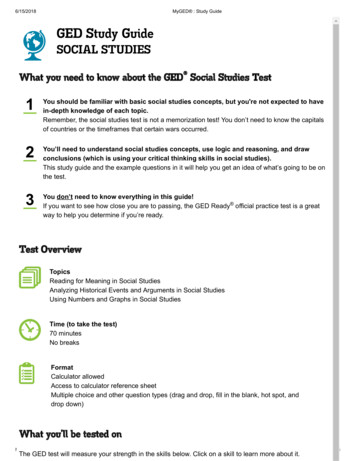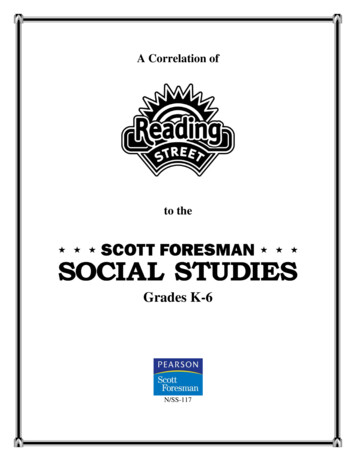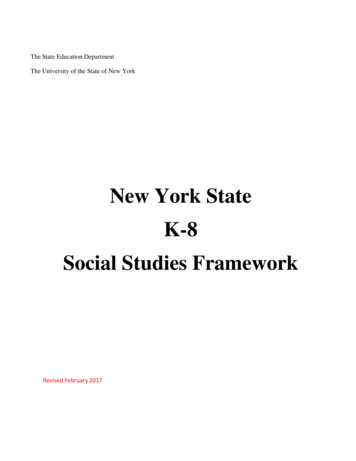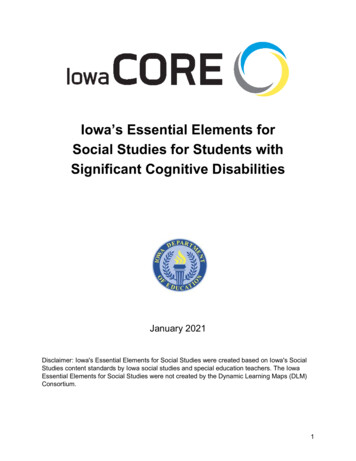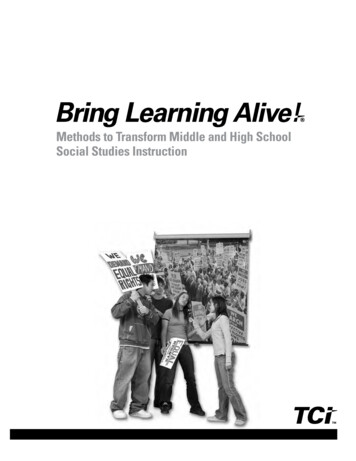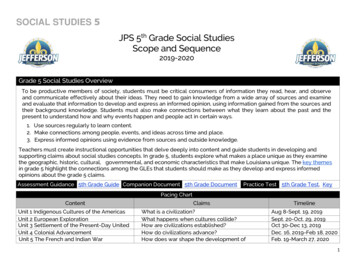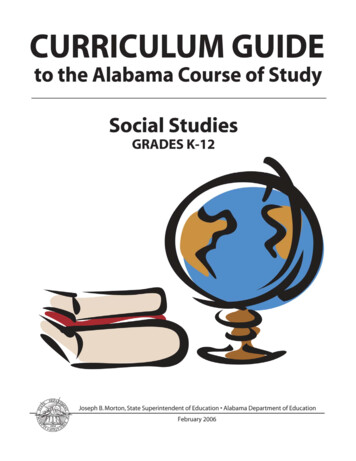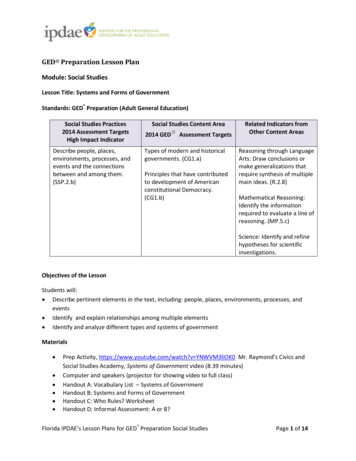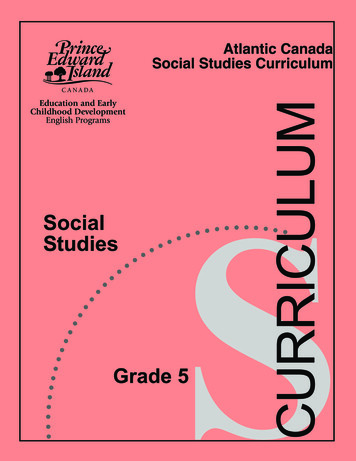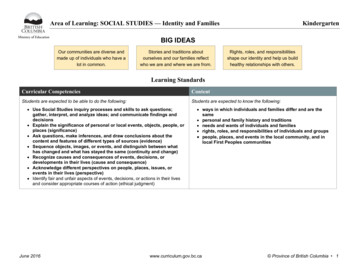
Transcription
Area of Learning: SOCIAL STUDIES — Identity and FamiliesMinistry of EducationKindergartenBIG IDEASOur communities are diverse andmade up of individuals who have alot in common.Stories and traditions aboutourselves and our families reflectwho we are and where we are from.Rights, roles, and responsibilitiesshape our identity and help us buildhealthy relationships with others.Learning StandardsCurricular CompetenciesContentStudents are expected to be able to do the following:Students are expected to know the following: Use Social Studies inquiry processes and skills to ask questions;gather, interpret, and analyze ideas; and communicate findings anddecisions Explain the significance of personal or local events, objects, people, orplaces (significance) Ask questions, make inferences, and draw conclusions about thecontent and features of different types of sources (evidence) Sequence objects, images, or events, and distinguish between whathas changed and what has stayed the same (continuity and change) Recognize causes and consequences of events, decisions, ordevelopments in their lives (cause and consequence) Acknowledge different perspectives on people, places, issues, orevents in their lives (perspective) Identify fair and unfair aspects of events, decisions, or actions in their livesand consider appropriate courses of action (ethical judgment)June 2016 ways in which individuals and families differ and are thesame personal and family history and traditions needs and wants of individuals and families rights, roles, and responsibilities of individuals and groups people, places, and events in the local community, and inlocal First Peoples communitieswww.curriculum.gov.bc.ca Province of British Columbia 1
SOCIAL STUDIESKindergartenCurricular Competencies – ElaborationsUse Social Studies inquiry processes and skills to ask questions; gather, interpret, and analyze ideas; and communicate findings and decisions:Key skills: Access information from audio, visual, material, or print sources.Collect information from personal experiences, oral sources, and visual representations.Contribute to a class collection of information on a common topic.With teacher support, use simple graphic organizers (e.g., Venn diagrams, t-charts) to identify similarities and differences.Identify a variety of ways of communicating (e.g., spoken language, facial expression, sign language, pictures, song, dance, drama).Present information orally (e.g., show and tell, introduce their partner).Create pictures to present information (e.g., a picture of their immediate environment, such as their classroom or a room in their home).Explain the significance of personal or local events, objects, people, or places (significance):Sample activity: Give a presentation about a family story or heirloom.Key questions: What is meant by significance? What makes something a personal or family treasure? Which events, objects, people, and places are significant to you?Ask questions, make inferences, and draw conclusions about the content and features of different types of sources (evidence):Sample activities: Identify interesting features in family photographs or other historical photographs. Speculate on what an artifact was used for or how old it is.Key question: Who do you think used this artifact and why?Sequence objects, images, or events, and distinguish between what has changed and what has stayed the same (continuity and change):Sample activities: Put significant personal and family milestones in order. Place objects in chronological order based on visual cues (e.g., older and newer houses or cars). Use appropriate terms to describe when events took place (e.g., then, now, long ago).Key questions: How was life different when your parents or grandparents were your age? How has your family changed over time?Recognize causes and consequences of events, decisions, or developments in their lives (cause and consequence):Key questions: How did a particular event make a difference in your life?June 2016www.curriculum.gov.bc.ca Province of British Columbia 2
What were the challenges or benefits of a particular event in your life?Acknowledge different perspectives on people, places, issues, or events in their lives (perspective):Sample activity: Compare how friends or members of your family feel about selected people, places, issues, and events.Key questions: Why do different people have different perspectives on issues? If two people have different perspectives or opinions, does it mean that one person is right and the other is wrong? Explain your answer.SOCIAL STUDIESKindergartenContent – Elaborationsways in which individuals and families differ and are the same:Sample topics: similarities and differences could include physical characteristics (e.g., hair, skin colour, eyes), cultural characteristics (e.g., language, family origins,food and dress), and other characteristics (e.g., preferred activities, favourite books and movies, pets, neighbourhood) different types of families (nuclear, extended, step-families, adoptive and biological, same-sex, single-parent, etc.) comparison of families in the past and present (e.g., families in your grandparents’ time compared with present-day families)Key questions: What is the definition of a family and an individual? What types of roles and responsibilities exist in families?personal and family history and traditions:Sample topics: important events in your life (e.g., starting school; losing a tooth; accepting a new baby; getting a new job, pet, or house) family stories (e.g., immigration to Canada, First Peoples oral histories, notable ancestors, memories from older relatives) traditions and celebrations (e.g., Christmas, other winter festivals around the world), special cultural holidays (e.g., Lunar New Year, Diwali, FirstPeoples celebrations, and birthdays) and associated foods, clothing, artKey questions: What types of stories get passed down from generation to generation? Why do people find traditions and celebrations important?needs and wants of individuals and families:Sample topics: needs (e.g., water, food, clothing, love and acceptance, safety, education, shelter) wants (toys, entertainment, luxuries, eating out at a restaurant) work that people do in their family and community to meet their needs and wantsKey questions: What is the difference between a need and a want (e.g., people need food to live, but ordering pizza is a want)? Do people agree on what are needs and what are wants?June 2016www.curriculum.gov.bc.ca Province of British Columbia 3
SOCIAL STUDIESKindergartenContent – Elaborationsrights, roles, and responsibilities of individuals and groups:Sample topics: rights (e.g., legal rights, UN Convention on the Rights of the Child) roles (e.g., roles within a family or on a sports team; roles as a friend, peer, student) responsibilities to self, others, and the environmentKey questions: Do your rights, roles, and responsibilities change between home and school? Who makes decisions about what happens at home or school?people, places, and events in the local community, and in local First Peoples communities:Sample topics: people (e.g., political leaders like the mayor or band council, school officials, local businesspeople) places (e.g., school, neighbourhoods, stores, parks, recreation facilities) events (e.g., new buildings, seasonal changes, sports) natural and human-built characteristics of the local physical environmentKey question: What people, places, or events are most significant to you? Is your list the same as your classmates’ or family’s list?June 2016www.curriculum.gov.bc.ca Province of British Columbia 4
Area of Learning: SOCIAL STUDIES — Local CommunitiesMinistry of EducationGrade 1BIG IDEASWe shape the local environment,and the local environment shapeswho we are and how we live.Our rights, roles, and responsibilitiesare important for buildingstrong communities.Healthy communities recognize andrespect the diversity of individualsand care for the local environment.Learning StandardsCurricular CompetenciesContentStudents are expected to be able to do the following:Students are expected to know the following: Use Social Studies inquiry processes and skills to ask questions; gather,interpret, and analyze ideas; and communicate findings and decisions Explain the significance of personal or local events, objects, people, orplaces (significance) Ask questions, make inferences, and draw conclusions about thecontent and features of different types of sources (evidence) Sequence objects, images, or events, and distinguish between what haschanged and what has stayed the same (continuity and change) Recognize causes and consequences of events, decisions, or developmentsin their lives (cause and consequence) Explore different perspectives on people, places, issues, or events in theirlives (perspective) Identify fair and unfair aspects of events, decisions, or actions in their lives andconsider appropriate courses of action (ethical judgment)June 2016 characteristics of the local community that provideorganization and meet the needs of the community diverse cultures, backgrounds, and perspectives within thelocal and other communities relationships between a community and its environment roles, rights, and responsibilities in the local community key events and developments in the local community, andin local First Peoples communities natural and human-made features of the local environmentwww.curriculum.gov.bc.ca Province of British Columbia 5
SOCIAL STUDIESGrade 1Curricular Competencies – ElaborationsUse Social Studies inquiry processes and skills to ask questions; gather, interpret, and analyze ideas; and communicate findings and decisions:Key skills: Recognize that maps are used to represent real places and relate pictorial representations to their physical locations.Follow a path to a destination using a pictorial representation (e.g., picture map).Access information from audio, visual, material, or print sources.Collect information from personal experiences, oral sources, and visual representations.Make comparisons to discover similarities and differences.With teacher prompts, make simple interpretations from information gathered (e.g., families have similar needs, families have differences).Use oral, written, or visual communication forms to accomplish given presentation tasks (e.g., show and tell, captioned pictures).Brainstorm, discuss, and compare possible solutions to a selected problem.Explain the significance of personal or local events, objects, people, or places (significance):Sample activities: Brainstorm a list of the most significant places in your community and explain why these locations are important. Research the history of a significant event or person in the history of your community.Key question: How does the significance of various events, objects, people, and places change over time?Ask questions, make inferences, and draw conclusions about the content and features of different types of sources (evidence):Sample activities: Compare old and new pictures of locations in your community and discuss how things have changed over time. Propose reasons for important events in your community and compare your hypotheses with the explanations of historians or other experts. Investigate the history of a significant person in your community using sources like news articles, photographs, and videos.Sequence objects, images, or events, and distinguish between what has changed and what has stayed the same (continuity and change):Sample activities: Create a visual timeline for important community events using photographs or drawings. Compare changes in technology in your parents’ and grandparents’ time. Distinguish between scheduled and unscheduled events.SOCIAL STUDIESGrade 1Content – Elaborationscharacteristics of the local community that provide organization and meet the needs of the community:Sample topics:June 2016www.curriculum.gov.bc.ca Province of British Columbia 6
SOCIAL STUDIESGrade 1Content – Elaborations local governmentpublic utilitiesemergency servicespolicingtransportationstoresparks and other recreational areasfinancial servicesdiverse cultures, backgrounds, and perspectives within the local and other communities:Sample topic: different languages, customs, art, music, traditions, holidays, food, clothing, and dressrelationships between a community and its environment:Sample topics: natural resource industries parks and other natural areas population growth and new construction water and sewage treatmentKey questions: How does your community depend on the local environment? What effects do the activities in your community have on the environment?roles, rights, and responsibilities in the local community:Sample topics: individual rights and interests versus the “public interest” responsibilities to other people and the environmentKey questions: Who gets to make decisions and why? How do decisions affect different people?key events and developments in the local community, and in local First Peoples communities:Sample topics: community milestones (e.g., the founding of the community, the opening and closing of local businesses, the construction of new buildings)celebrations and holidayscultural eventsgrowth or decline of a communityJune 2016www.curriculum.gov.bc.ca Province of British Columbia 7
SOCIAL STUDIESGrade 1Content – ElaborationsKey questions: What is the most significant event in your local community’s history? How is your community different now from what it was like before settlers arrived?natural and human-made features of the local environment:Sample topics: natural features: mountains, forests, waterways, local plants and animals human-made features: buildings, bridges, dams, dykesKey question: How does the rural environment differ from the urban environment?June 2016www.curriculum.gov.bc.ca Province of British Columbia 8
Area of Learning: SOCIAL STUDIES — Regional and Global CommunitiesMinistry of EducationGrade 2BIG IDEASLocal actions have globalconsequences, and global actionshave local consequences.Canada is made up of many diverseregions and communities.Individuals have rights andresponsibilities as global citizens.Learning StandardsCurricular CompetenciesContentStudents are expected to be able to do the following:Students are expected to know the following: Use Social Studies inquiry processes and skills to ask questions;gather, interpret, and analyze ideas; and communicate findings anddecisions Explain why people, events, or places are significant to variousindividuals and groups (significance) Ask questions, make inferences, and draw conclusions about thecontent and features of different types of sources (evidence) Sequence objects, images, and events, or explain why some aspectschange and others stay the same (continuity and change) Recognize causes and consequences of events, decisions, ordevelopments (cause and consequence) Explain why people’s beliefs, values, worldviews, experiences, androles give them different perspectives on people, places, issues, orevents (perspective) Make value judgments about events, decisions, or actions, and suggestlessons that can be learned (ethical judgment)June 2016 diverse characteristics of communities and cultures inCanada and around the world, including at least oneCanadian First Peoples community and culture how people’s needs and wants are met in communities relationships between people and the environment indifferent communities diverse features of the environment in other parts of Canadaand the world rights and responsibilities of individuals regionallyand globally roles and responsibilities of regional governmentswww.curriculum.gov.bc.ca Province of British Columbia 9
SOCIAL STUDIESGrade 2Curricular Competencies – ElaborationsUse Social Studies inquiry processes and skills to ask questions; gather, interpret, and analyze ideas; and communicate findings and decisions:Key skills: Use cardinal directions to identify relative locations on simple maps (e.g., the school is north of the park).Interpret symbols and legends on maps to identify given locations in the community (e.g., schools, roads, railways, playgrounds, museums).Create simple maps of familiar locations (e.g., the school and grounds).Use simple graphic organizers (e.g., charts, webs) to record relevant information from selected sources.Use selected communication forms (e.g., presentation software, models, maps, oral, written) to accomplish given presentation tasks.Ask relevant questions to clarify a classroom or school problem.Brainstorm and compare a variety of responses to a given classroom or school problem.Predict the possible results of various solutions to a problem.Explain why people, events, or places are significant to various individuals and groups (significance):Sample activity: Identify significant people and places in BC, Canada, and the world.Key questions: Why do people have different opinions on what people, events, and places are more significant than others? Are there people, events, and places that everyone thinks are significant? Explain why or why not.Ask questions, make inferences, and draw conclusions about the content and features of different types of sources (evidence):Sample activities: Conduct research (e.g., interview an Elder, visit a museum) to identify changes that have occurred in your community. Examine photographs from a variety of communities and identify similarities and differences.Sequence objects, images, and events, or explain why some aspects change and others stay the same (continuity and change):Sample activities: Create a timeline of key events in your region. Make simple predictions about how communities might change in the future. Conduct research (e.g., interview an Elder, visit a museum) to identify changes that have occurred in your community. Give examples of traditions and practices that have endured over time in the communities you have studied.Key questions: How has Canada changed over time? How have people’s needs and wants changed over time? What needs and wants have changed and which have stayed the same?Recognize causes and consequences of events, decisions, or developments (cause and consequence):Key questions: What would happen if people did not take care of their local environment? What would happen if there was nobody leading a community or country?June 2016www.curriculum.gov.bc.ca Province of British Columbia 10
Explain why people’s beliefs, values, worldviews, experiences, and roles give them different perspectives on people, places, issues, or events(perspective):Sample activities: Give examples of issues on which there are differing points of view. Give examples of diverse perspectives on meeting your community’s needs and wants.Key questions: Does everyone agree on the importance of conservation? Who should make decisions about the future of the community and country?Make value judgments about events, decisions, or actions, and suggest lessons that can be learned (ethical judgment):Sample activity: Distinguish between factual statements and value and opinion statements.Key questions: What should be done about the distribution of natural resources? Should more wealthy countries help out less prosperous countries?SOCIAL STUDIESGrade 2Content – Elaborationsdiverse characteristics of communities and cultures in Canada and around the world, including at least one Canadian First Peoples communityand culture:Sample topics: daily life in different communities (e.g., work, housing, use of the land, education, access to public services and utilities, transportation) key cultural aspects (e.g., language, traditions, arts, food) cultural diversity within your communityKey question: What does community mean to you?how people’s needs and wants are met in communities:Sample topics: how people acquire goods and services (e.g., by buying or renting, or through public funding) needs and wants in different communities: different needs and wants depending on the climate; different goods and services depending on the sizeof the community (i.e., small versus large) differences between psychological and physical needs and wantsKey questions: How do the local environment and culture affect the goods and services available in your community? How do different communities help people who can’t meet their basic needs?relationships between people and the environment in different communities:Sample topics:June 2016www.curriculum.gov.bc.ca Province of British Columbia 11
SOCIAL STUDIESGrade 2Content – Elaborations impact of different economic activities and ways of life on the environment impact on the environment of small and large communities impact of recreational activities on the environment community values regarding conservation and protection of the environmentKey question: What types of environmental challenges do people face in different communities (e.g., natural disasters, climate change, lack of natural resources)?diverse features of the environment in other parts of Canada and the world:Sample topics: climate zoneslandformsbodies of waterplants and animalsrights and responsibilities of individuals regionally and globally:Sample topics: responsibility to the environment human rights connections between your community and communities throughout Canada and around the worldroles and responsibilities of regional governments:Sample topics: examples of leaders in your community (e.g., mayor, town councillors, chief, Elders, community volunteers) and the places where they meet services such as transportation, policing, firefighting, bylaw enforcementKey questions: How are decisions made in your region? Should everyone be responsible for helping others in their community?June 2016www.curriculum.gov.bc.ca Province of British Columbia 12
Area of Learning: SOCIAL STUDIES — Global Indigenous PeoplesMinistry of EducationLearning about indigenouspeoples nurtures multiculturalawareness and respectfor diversity.Grade 3BIG IDEASPeople from diverse cultures andsocieties share some commonexperiences and aspects of life.Indigenous knowledge is passeddown through oral history,traditions, and collective memory.Indigenous societies throughoutthe world value the well-beingof the self, the land, spirits,and ancestors.Learning StandardsCurricular CompetenciesContentStudents are expected to be able to do the following:Students are expected to know the following: Use Social Studies inquiry processes and skills to ask questions; gather,interpret, and analyze ideas; and communicate findings and decisions Explain why people, events, or places are significant to various individuals andgroups (significance) Ask questions, make inferences, and draw conclusions about the content andfeatures of different types of sources (evidence) Sequence objects, images, or events, and explain why some aspects change andothers stay the same (continuity and change) Recognize causes and consequences of events, decisions, or developments(cause and consequence) Explain why people’s beliefs, values, worldviews, experiences, and roles givethem different perspectives on people, places, issues, or events (perspective) Make value judgments about events, decisions, or actions, and suggest lessonsthat can be learned (ethical judgment)June 2016www.curriculum.gov.bc.ca cultural characteristics and ways of life of localFirst Peoples and global indigenous peoples aspects of life shared by and common to peoplesand cultures interconnections of cultural and technologicalinnovations of global and local indigenous peoples governance and social organization in local andglobal indigenous societies oral history, traditional stories, and artifacts asevidence about past First Peoples cultures relationship between humans and theirenvironment Province of British Columbia 13
SOCIAL STUDIESGrade 3Curricular Competencies – ElaborationsUse Social Studies inquiry processes and skills to ask questions; gather, interpret, and analyze ideas; and communicate findings and decisions:Key skills: Ask relevant questions to clarify and define a selected problem or issue. Make predictions in relation to a selected problem or issue. Compare, classify, and identify patterns in information about a selected problem or issue. Interpret information on simple maps using cardinal directions, symbols, and legends. Create simple maps to represent the community and one or more other communities within BC and Canada. Gather information on a topic from more than one source (e.g., book, magazine, website, interview). Apply strategies for information gathering (e.g., using headings, indices, tables of contents). Cite information sources appropriately (e.g., simple bibliography). Individually, or in groups, design a course of action to address a problem or issue, and provide reasons to support the action.Explain why people, events, or places are significant to various individuals and groups (significance):Key questions: Why are stories important to indigenous people? Why do Elders play an important part in the lives of First Peoples? What values were significant for local First Peoples?Ask questions, make inferences, and draw conclusions about the content and features of different types of sources (evidence):Sample activity: View different artifacts from indigenous cultures and speculate on what they might have been used for.Sequence objects, images, or events, and explain why some aspects change and others stay the same (continuity and change):Sample activities: Use examples to show that events happen in chronological sequence (e.g., last month, yesterday, today, tomorrow, next month). Organize and present information in chronological order (e.g., before, now, later; past, present, future).Key questions: How has the way of life changed for indigenous people? How are indigenous cultures viewed today? How have First Peoples government and leadership changed over time?Recognize causes and consequences of events, decisions, or developments (cause and consequence)Key questions: How might present-day Canada be different if First Peoples had not been moved to reserves? How has the way of life changed for indigenous people?Explain why people’s beliefs, values, worldviews, experiences, and roles give them different perspectives on people, places, issues, orevents (perspective):June 2016www.curriculum.gov.bc.ca Province of British Columbia 14
Sample activities: Distinguish between fact and opinion on a selected problem or issue. Identify features of indigenous cultures that characterize their relationship to the land. Explain indigenous peoples’ use of oral tradition rather than written language.Key question: How do the values of indigenous people differ from the values of people from other cultures?Make value judgments about events, decisions, or actions, and suggest lessons that can be learned (ethical judgment):Key questions: Is the technology we have today better than the traditional technology of indigenous peoples?What are the advantages or disadvantages of consensus decision making?Should indigenous cultures and languages be maintained? Explain the reasons for your answer.Should anything be done about the loss of indigenous lands? Explain your reasons.SOCIAL STUDIESGrade 3Content – Elaborationscultural characteristics and ways of life of local First Peoples and global indigenous peoples:Sample topics: potential First Peoples and global indigenous people for study could include:— Local BC First Peoples— Canadian and other North American indigenous people— local indigenous peoples of South America— ethnic Chinese and Koreans— ethnic European groups (Germanic, Slavic, Latin, Celtic) worldview, protocols, celebrations, ceremonies, dance, music, spiritual beliefs, art, values, kinship, traditional teachingsaspects of life shared by and common to peoples and cultures:Sample topics: family work education systems of ethics and spiritualityinterconnections of cultural and technological innovations of global and local indigenous peoples:Sample topics: transportation clothing pottery shelters and buildings navigation weaponsJune 2016www.curriculum.gov.bc.ca Province of British Columbia 15
SOCIAL STUDIESGrade 3Content – Elaborations toolshunting and fishing techniquesbuilding techniquesfood cultivation and preparationceremoniesartmusicbasketry and weavinggovernance and social organization in local and global indigenous societies:Sample topics: consensus confederacies Elders reservations band councils traditional leadershiporal history, traditional stories, and artifacts as evidence about past First Peoples cultures:Sample topics: toolsearth moundspetroglyphsoral storiessacred or significant places and landformsweaponsrelationship between humans and their environment:Sample topics: protocols around the world that acknowledge and respect the landreshaping of the land for resource exploration and developmentdomestication of animalsorganization and techniques of hunting and fishingJune 2016www.curriculum.gov.bc.ca Province of British Columbia 16
Area of Learning: SOCIAL STUDIES — First Peoples and European ContactBIG IDEASMinistry of EducationThe pursuit of valuable naturalresources has played a key role inchanging the land, people, andcommunities of Canada.Grade 4Interactions between First Peoplesand Europeans led to conflict andco-operation, which continue toshape Canada’s identity.Demographic changes in NorthAmerica created shifts ineconomic and political power.British Columbia followed aunique path in becoming apart of Canada.Learning StandardsCurricular CompetenciesCont
SOCIAL STUDIES Curricular Competencies - Elaborations Grade 1 Use Social Studies inquiry processes and skills to ask questions; gather, interpret, and analyze ideas; and communicate findings and decisions: Key skills: Recognize that maps are used to represent real places and relate pictorial representations to their physical locations.
